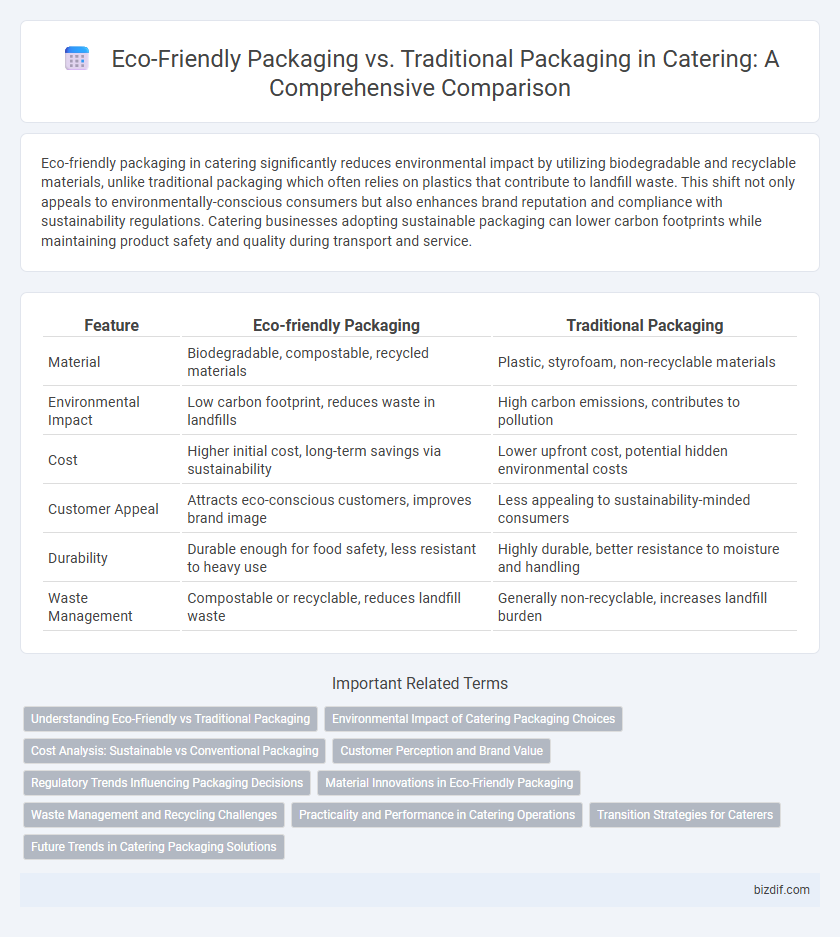Eco-friendly packaging in catering significantly reduces environmental impact by utilizing biodegradable and recyclable materials, unlike traditional packaging which often relies on plastics that contribute to landfill waste. This shift not only appeals to environmentally-conscious consumers but also enhances brand reputation and compliance with sustainability regulations. Catering businesses adopting sustainable packaging can lower carbon footprints while maintaining product safety and quality during transport and service.
Table of Comparison
| Feature | Eco-friendly Packaging | Traditional Packaging |
|---|---|---|
| Material | Biodegradable, compostable, recycled materials | Plastic, styrofoam, non-recyclable materials |
| Environmental Impact | Low carbon footprint, reduces waste in landfills | High carbon emissions, contributes to pollution |
| Cost | Higher initial cost, long-term savings via sustainability | Lower upfront cost, potential hidden environmental costs |
| Customer Appeal | Attracts eco-conscious customers, improves brand image | Less appealing to sustainability-minded consumers |
| Durability | Durable enough for food safety, less resistant to heavy use | Highly durable, better resistance to moisture and handling |
| Waste Management | Compostable or recyclable, reduces landfill waste | Generally non-recyclable, increases landfill burden |
Understanding Eco-Friendly vs Traditional Packaging
Eco-friendly packaging in catering uses biodegradable, compostable, or recyclable materials, significantly reducing environmental impact compared to traditional packaging made from plastics and non-renewable resources. Key benefits include minimizing waste in landfills, lowering carbon footprints, and promoting sustainability, which align with growing consumer demand for environmentally responsible options. Traditional packaging often involves single-use plastics that contribute to pollution, whereas eco-friendly alternatives support circular economy principles and transparent supply chains.
Environmental Impact of Catering Packaging Choices
Eco-friendly packaging in catering significantly reduces waste by utilizing biodegradable, compostable, or recyclable materials that decompose faster and minimize landfill burden. Traditional packaging, often composed of plastic and Styrofoam, contributes to long-lasting pollution and increased carbon emissions during production and disposal processes. Choosing sustainable packaging options supports lower environmental footprints and aligns with global efforts to combat plastic pollution and climate change.
Cost Analysis: Sustainable vs Conventional Packaging
Eco-friendly packaging often incurs higher upfront costs due to materials like biodegradable plastics or recycled paper, but can reduce long-term expenses through lower waste disposal fees and potential tax incentives. Traditional packaging generally offers lower initial purchase prices but may lead to increased environmental compliance costs and negative brand perception. Businesses prioritizing sustainability may achieve better cost efficiency by integrating eco-friendly packaging solutions in their catering operations.
Customer Perception and Brand Value
Eco-friendly packaging enhances customer perception by aligning with growing environmental concerns, leading to increased brand loyalty and positive word-of-mouth. Compared to traditional packaging, sustainable materials signal a company's commitment to social responsibility, boosting overall brand value and differentiation in a competitive catering market. Brands adopting eco-friendly packaging often experience higher customer trust and preference, directly impacting sales and market positioning.
Regulatory Trends Influencing Packaging Decisions
Regulatory trends increasingly favor eco-friendly packaging as governments implement stricter waste reduction and recycling mandates, such as the EU's Single-Use Plastics Directive and California's Extended Producer Responsibility laws. These regulations push catering businesses to adopt biodegradable, compostable, or recyclable materials to ensure compliance and avoid fines. Traditional packaging faces growing restrictions due to rising environmental concerns and the global shift toward sustainable supply chain practices.
Material Innovations in Eco-Friendly Packaging
Material innovations in eco-friendly packaging for catering include biodegradable bioplastics derived from plant-based sources such as cornstarch and sugarcane, which reduce reliance on petroleum-based plastics. Compostable packaging made from materials like molded fiber, bagasse, and recycled paper offers sustainable alternatives that break down naturally without harming the environment. These innovations support waste reduction goals while maintaining durability and food safety standards essential for catering operations.
Waste Management and Recycling Challenges
Eco-friendly packaging in catering significantly reduces landfill waste by utilizing biodegradable materials that decompose faster than traditional plastics. Traditional packaging often involves mixed materials that complicate recycling processes, leading to higher contamination rates in waste streams. Adopting eco-friendly alternatives addresses waste management challenges by promoting circular economy principles and enhancing the efficiency of recycling programs.
Practicality and Performance in Catering Operations
Eco-friendly packaging offers sustainable benefits by using biodegradable and compostable materials, reducing environmental impact without compromising the functionality required in catering operations. Traditional packaging remains favored for its proven durability, moisture resistance, and cost-effectiveness in large-scale food transport and storage. Practicality in catering depends on balancing eco-conscious consumer demands with the need for reliable packaging that maintains food safety and quality during delivery and service.
Transition Strategies for Caterers
Transition strategies for caterers moving from traditional packaging to eco-friendly options include conducting comprehensive supplier evaluations to source sustainable materials such as biodegradable containers and compostable cutlery. Implementing staff training programs ensures proper handling and disposal of eco-friendly packaging, enhancing operational efficiency while reducing environmental impact. Monitoring customer feedback and waste management metrics helps caterers continuously optimize packaging choices and promote sustainability in their service offerings.
Future Trends in Catering Packaging Solutions
Eco-friendly packaging in catering is rapidly gaining traction due to increasing consumer demand for sustainable and biodegradable materials such as plant-based plastics, bamboo, and recycled paper. Future trends indicate a shift towards smart packaging integrated with sensors to monitor food freshness and reduce waste, alongside innovations in compostable and reusable containers to minimize environmental impact. Traditional packaging, primarily single-use plastics and Styrofoam, faces declining acceptance as regulations tighten and eco-conscious consumers prioritize green alternatives.
Eco-friendly packaging vs Traditional packaging Infographic

 bizdif.com
bizdif.com